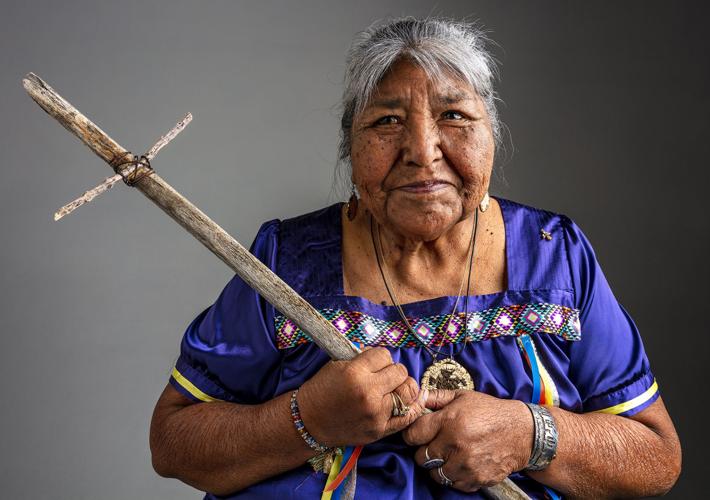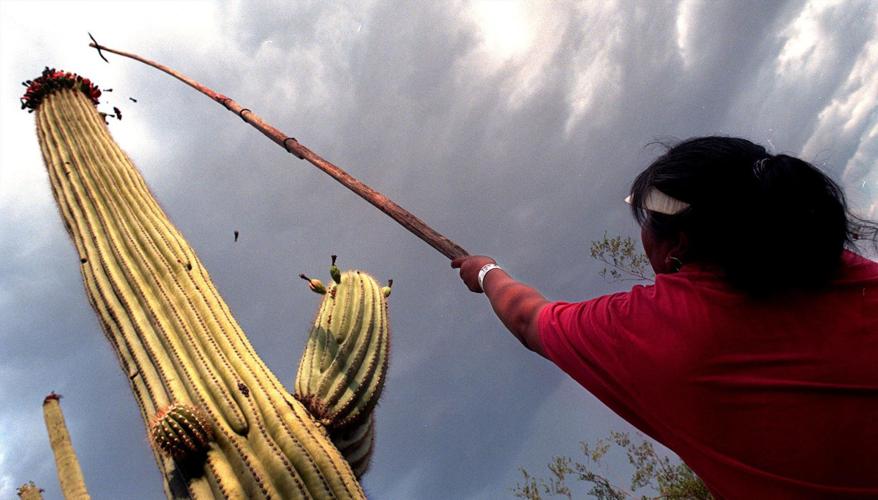Tohono O’odham elder Stella Tucker, who spread her knowledge about the art of saguaro fruit harvesting to all who wanted to learn, died Jan. 9. She was 71.
Tucker died at Tucson Medical Center after a long illness from kidney and liver complications, said her daughter, Tanisha Tucker. She was surrounded by her family.
“She taught me patience and gave me strength,” said Tanisha of her mother.
“She taught me endurance and compassion for others. She taught me to respect and love the land. She was a very kind and amazing woman. She will be missed by many people.”
Tanisha joined her mother at the annual saguaro fruit harvest camp and hosted workshops to keep the ancient saguaro fruit tradition alive and to engage O’odham youths in the harvest.
“I started learning the tradition when I was about 7 and I decided to carry it on as my mother aged,” said the daughter, who was proud that Stella “taught thousands about saguaro fruit harvesting over more than two decades.”
During the last seven years, the cultural tradition has started to revive among O’odham children who are learning the art through community programs, including the Tucson Indian Center and Tohono O’odham Community Action, a nonprofit grassroots organization that supports traditional farming, healthy foods and tribal culture, Tanisha said.
The annual centuries-old tradition of saguaro fruit harvesting, or Ha:san Bak, to make syrup, jam and wine, was a part of life in Tucker’s family for more than 100 years.
The elder Tucker, who was born in Topawa — a community south of Sells, the nation’s capital — learned the art from her grandparents, parents and her late aunt, Juanita Ahil.
Ahil harvested on lands that in 1961 were designated by the U.S. Interior Department as Saguaro National Monument. The monument was established in 1933, and additional lands were added over the years. It later was named a national park.
The monument designation in 1961 threatened Ahil’s saguaro fruit harvesting camp, and among her supporters were friends and educators from the Arizona-Sonora Desert Museum who wrote a letter on behalf of Ahil.
Then-Secretary of the Interior Stuart Udall granted permission for the harvest to continue, said Kimi Eisele, a family friend.
After Ahil’s death in 1994, Stella Tucker took over the camp. In a 2007 interview with the Arizona Daily Star, Tucker remembered when O’odham families camped in the desert for weeks to harvest and cook saguaro fruit.
“I used to harvest on the weekends with my grandmother when I was a child,” said Tucker. “My family used to harvest near Saguaro National Park West. In the early ’70s, the government granted the (Tohono O’odham) Nation a permit to harvest on national park property.
“My grandmother started a camp in the 1970s off of Sandario Road, which I took over in the 1980s,” she said.
At the time, Tucker worked as a nutritionist at San Xavier Mission school and would be off during the summer, which allowed her the time to harvest saguaro fruit in June and July.
In a plentiful season, Tucker and volunteers would produce gallons of syrup and jam, which Tucker would sell from her home in Tucson, and to tribal elders who were not able to harvest anymore.
The group picked the fruit from the saguaro using a saguaro-ribbed tool called a KuipaD to knock the fruit to the ground, often from more than 30 feet up in the air.
The tool is made of two dried saguaro ribs lashed together. At one end of the ribs, a greasewood stick juts from either side, forming a cross.
Tucker passed her knowledge on at the harvesting camps to students, scientists, artists and family. She worked to teach the interrelationship between the O’odham, the saguaro and the Sonoran Desert. Tucker also taught many workshops at the Arizona-Sonora Desert Museum, said Eisele.
“Stella was very patient and willing to share the knowledge she possessed,” said Tina Vavages-Andrew, the ancestral ranger at Saguaro National Park, a post in which she sustains a relationship between tribal nations and the park service. Vavages-Andrew organized visits to the camp for youths, among others, every year. “I most enjoyed her personal stories of her harvesting experiences,” she said.
In 2018, Tucker was awarded a Master-Apprentice Artist Award from the Southwest Folklife Alliance in honor of her work upholding, preserving and teaching the saguaro harvesting tradition, said her daughter.
In addition to Tanisha Tucker, Stella Tucker is survived by daughter Staycie Francisco; a brother, Ed Francisco; a sister, Caroline Lopez; and numerous nieces and nephews.
A 9 a.m. funeral Mass is set for Saturday, Jan. 19, at Mission San Xavier del Bac, 1950 W. San Xavier Road. A 10 a.m. rosary will be recited the same day at the San Xavier Community Rock House, west of the mission, followed by a traditional feast.
Photos: Stella Tucker, Tohono O’odham keeper of Saguaro Fruit Harvest, dies at 71
Stella Tucker
Updated
Stella Tucker, who will come out to the saguaro fields for as long as she's able, laughs with friends and family during end of the harvest party in 1998.
Stella Tucker
Updated
Stella Tucker, 49, does not mind the 100-degree days picking saguaro fruit and remains very upbeat as one of only a few Tohono O’odham people keeping the tradition of harvest each June.
Stella Tucker
Updated
Stella Tucker and Anna Gomez, Tohono O’odham Tribe members, finish cooking a small amount of saguaro fruit into a syrup at their small camp in the Saguaro National Park near the Tucson Mountain Park. Stella and Anna have been out here since the first of June when the harvest began and lasts about 30 days.
Stella Tucker
Updated
Stella Francisco Tucker looks for saguaro fruit to harvest in Saguaro National Park July 5th, 2007 in Tucson, Ariz. Tucker is a member of the Tohono O’odham nation, has harvested saguaro fruit for more than thirty years. The area that she camps at every June used to be her grandmother's camp. "Parents have to get their children involved in harvesting, otherwise we will lose this and it will be forgotten" Tucker said.
Stella Tucker
Updated
Stella Francisco Tucker gets coffee at her saguaro harvest camp in Saguaro National Park July 5th, 2007 in Tucson, Ariz. Tucker who is a member of the Tohono O’odham nation, has harvested saguaro fruit for more than thirty years. Tucker and other campers get up early in the morning to pick their fruit before it gets to hot. Once their done picking for the day, the long cooking process starts.
Stella Tucker
Updated
Stella Francisco Tucker pours fruit into a bucket in preparation for it to be cooked at her camp in Saguaro National Park July 5th, 2007 in Tucson, Ariz. The fruit is soaked in water before it's cooked. The fruit is cooked once and then sifted twice (first through a screen, and then sifted using cheese cloth). The leftover contents are then cooked for a second time after which you end up with syrup.
Stella Tucker
Updated
Stella Francisco Tucker separates seeds from the fiber of saguaro fruit which has been boiled and dried at her saguaro harvest camp in Saguaro National Park, Thursday July 5th, 2007 in Tucson, Ariz.
Stella Tucker
Updated
Stella Francisco Tucker places boiled saguaro fruit through a cheese cloth screen at Tucker's Saguaro harvesting camp in Saguaro National Park July 5th, 2007 in Tucson, Ariz. Saguaro fruit is soaked in water before it is cooked. The fruit is then cooked once and then sifted twice(first through a screen, and then sifted using cheese cloth As in this photo). The left over contents is then cooked for a second time after which you end up with syrup.
Stella Tucker
Updated
Stella Francisco Tucker bottom right, picks up saguaro fruit that has blown off a saguaro overnight in Saguaro National Park on July 5th, 2007 in Tucson, Ariz.
Stella Tucker
Updated
Stella Francisco Tucker, right, hands Justin Manuel coffee in the morning before going out to harvest saguaro fruit at Tucker's camp in Saguaro National Park, July 5th, 2007 in Tucson, Ariz.
Stella Tucker
Updated
Stella Tucker uses a kuipaD, lengths of saguaro ribs bound together with a branch of creosote bush, to harvest saguaro fruit in the Saguaro National Park, Tucson, AZ., June 16, 2005. During the early summer Tucker camps out in the park to harvest and refine the fruit as her Tohono O'odham ancestors did.
Stella Tucker
Updated
Stella Tucker uses the sharp edge of a stem of a saguaro fruit to slice the husk to get to the sweet meat inside as she harvests saguaro fruit in the Saguaro National Park, Tucson, AZ., Thursday, June 16, 2005.
Stella Tucker
Updated
Stella Tucker, working in her Saguaro National Monument campsite filled with pots and pans, babies her brew through each step of the process, making sure it doesn't burn in 1998.
Stella Tucker
Updated
Stella Tucker uses a harvesting pole made from two saguaro ribs held together with metal twine to knock down the ripe fruits bursting from the tops of the saguaros in the Saguaro National Monument in 1998.
Stella Tucker
Updated
As her morning harvest ends Stella Tucker gathers her things and heads off back to her camp, alone, but with her pail full in 1998.
Stella Tucker
Updated
When Stella Tucker is making jam as instead of just syrup, she adds the fruit fiber she strained out earlier when collecting seeds to thicken it into jam. 1998.






